Assessing Crop Water Productivity under Different Irrigation Scenarios in the Mid–Atlantic Region
Abstract
:1. Introduction
2. Materials and Methods
2.1. Study Area
2.2. SWAT Model
2.3. Model Setup
2.3.1. Model Input and Data Collection
2.3.2. Crop Management
2.3.3. Parameter Selection and Streamflow Calibration
2.3.4. Crop Yield Calibration
2.4. Scenarios Analysis
3. Results and Discussion
3.1. Streamflow
3.2. Crop Yield
3.3. Irrigation Requirement
3.4. Water Productivity
3.5. Further Discussion
4. Conclusions
Author Contributions
Funding
Institutional Review Board Statement
Informed Consent Statement
Data Availability Statement
Conflicts of Interest
References
- Boesch, D.F. Comprehensive Assessment of Climate Change Impacts in Maryland. In Report to the Maryland Commission on Climate Change; Maryland Department of the Environment: Baltimore, MD, USA, 2008. [Google Scholar]
- Cultice, A.K.; Bosch, D.J.; Pease, J.W.; Boyle, K.J. Horticultural producers’ willingness to adopt water recirculation technology in the Mid–Atlantic region. In Proceedings of the Agricultural & Applied Economics Association’s 2013 AAEA & CAES Joint Annual Meeting, Washington, DC, USA, 4–6 August 2013. [Google Scholar]
- NOAA–NCEI. NOAA National Centers for Environmental Information, State Climate Summaries, Maryland and District of Columbia. 2019. Available online: https://statesummaries.ncics.org/chapter/md/ (accessed on 25 January 2021).
- Luck, M.; Landis, M.; Gassert, F. Aqueduct Water Stress Projections: Decadal Projections of Water Supply and Demand Using CMIP5 GCMs; World Resources Institute: Washington, DC, USA, 2015. [Google Scholar]
- Paul, M.; Dangol, S.; Kholodovsky, V.; Sapkota, A.R.; Negahban–Azar, M.; Lansing, S. Modeling the Impacts of Climate Change on Crop Yield and Irrigation in the Monocacy River Watershed, USA. Climate 2020, 8, 139. [Google Scholar] [CrossRef]
- USGS. Water Use in the United States. 2021. Available online: https://water.usgs.gov/watuse/data/ (accessed on 25 January 2021).
- Wheeler, J.C. Freshwater–Use Trends in Maryland, 1985–2000; US Geological Survey: Places Reston, VA, USA, 2003.
- NASS. National Agricultural Statistics Service, Agricultural Statistics 2009; USDA: Washington, DC, USA, 2009.
- NOAA. Climate Data Online. 2020. Available online: https://www.ncdc.noaa.gov/cdo–web/ (accessed on 26 January 2021).
- Paul, M.; Negahban–Azar, M.; Shirmohammadi, A.; Montas, H. Developing a Multicriteria Decision Analysis Framework to Evaluate Reclaimed Wastewater Use for Agricultural Irrigation: The Case Study of Maryland. Hydrology 2021, 8, 4. [Google Scholar] [CrossRef]
- Shirmohammadi, A.M.; Rowe, S.; Kasraei, R.; Summers, B.; Michael, R.; Ortt, H.; Schmidt, R.; Shedlock, D.; Nemazi, M.; Negahban–Azar, M.; et al. Stressed Aquifers on the Coastal Plain of Maryland. In Proceedings of the American Geophysical Union (AGU), Quest for Sustainability of Heavily Stressed Aquifers at regional to Global Scales, Valencia, Spain, 21–24 October 2019. [Google Scholar]
- MDA. Agriculture in Maryland: Summary for 2010; Maryland Department of Agriculture: Annapolis, MD, USA, 2011.
- Immerzeel, W.; Gaur, A.; Zwart, S. Integrating remote sensing and a process–based hydrological model to evaluate water use and productivity in a south Indian catchment. Agric. Water Manag. 2008, 95, 11–24. [Google Scholar] [CrossRef]
- Keller, A.; Keller, J. Effective Efficiency: A water Use Concept for Allocating Fresh Water Resources and Irrigation Division Discussion Paper; Winrock International: Arlington, VA, USA, 1995. [Google Scholar]
- Garg, K.K.; Bharati, L.; Gaur, A.; George, B.; Acharya, S.; Jella, K.; Narasimhan, B. Spatial Mapping of Agricultural Water Productivity using the Swat Model in Upper Bhima Catchment, India. Irrig. Drain. 2011, 61, 60–79. [Google Scholar] [CrossRef] [Green Version]
- Han, X.; Wei, Z.; Zhang, B.; Han, C.; Song, J. Effects of Crop Planting Structure Adjustment on Water Use Efficiency in the Irrigation Area of Hei River Basin. Water 2018, 10, 1305. [Google Scholar] [CrossRef] [Green Version]
- Luan, X.; Wu, P.; Sun, S.; Wang, Y.; Gao, X. Quantitative study of the crop production water footprint using the SWAT model. Ecol. Indic. 2018, 89, 1–10. [Google Scholar] [CrossRef]
- CCBRM. Upper Monocacy River Watershed Characterization Plan. 2016. Available online: https://www.carrollcountymd.gov/media/2326/upper–monocacy–river–characterization–plan.pdf (accessed on 26 January 2021.).
- Renzulli, M. Wettest Places in the USA. 2020. Available online: https://www.tripsavvy.com/wettest–places–in–the–usa–4135027 (accessed on 29 June 2021).
- NRCS–USDA. Natural Resources Conservation Service Soils USDA. 2019. Available online: https://www.nrcs.usda.gov/wps/portal/nrcs/detail/soils/survey/?cid=nrcs142p2_053627 (accessed on 5 May 2019).
- USDA–NASS. Cropland Data Layer. National Agricultural Statistics. 2018. Available online: https://nassgeodata.gmu.edu/CropScape/ (accessed on 1 February 2021).
- Lewis, J. Estimating Irrigation Water Requirements to Optimize Crop Growth (FS–447); University of Maryland Extension: Cumberland, MD, USA, 2014. [Google Scholar]
- Narsimlu, B.; Gosain, A.K.; Chahar, B.R.; Singh, S.K.; Srivastava, P.K. SWAT Model Calibration and Uncertainty Analysis for Streamflow Prediction in the Kunwari River Basin, India, Using Sequential Uncertainty Fitting. Environ. Process. 2015, 2, 79–95. [Google Scholar] [CrossRef]
- Yesuf, H.M.; Melesse, A.M.; Zeleke, G.; Alamirew, T. Streamflow prediction uncertainty analysis and verification of SWAT model in a tropical watershed. Environ. Earth Sci. 2016, 75, 1–16. [Google Scholar] [CrossRef]
- Srinivasan, R.; Zhang, X.; Arnold, J.G. SWAT Ungauged: Hydrological Budget and Crop Yield Predictions in the Upper Mississippi River Basin. Trans. ASABE 2010, 53, 1533–1546. [Google Scholar] [CrossRef]
- Bauwe, A.; Kahle, P.; Lennartz, B. Evaluating the SWAT model to predict streamflow, nitrate loadings and crop yields in a small agricultural catchment. Adv. Geosci. 2019, 48, 1–9. [Google Scholar] [CrossRef] [Green Version]
- Arnold, J.G.; Moriasi, D.N.; Gassman, P.W.; Abbaspour, K.C.; White, M.J.; Srinivasan, R.; Santhi, C.; Harmel, R.D.; van Griensven, A.; Van Liew, M.W.; et al. SWAT: Model Use, Calibration, and Validation. Trans. ASABE 2012, 55, 1491–1508. [Google Scholar] [CrossRef]
- Neitsch, S.L.; Arnold, J.G.; Kiniry, J.R.; Williams, J.R. Soil and Water Assessment Tool Theoretical Documentation Version 2009; Texas Water Resources Institute: College Station, TX, USA, 2011. [Google Scholar]
- USGS. US Geological Survey National Map Database. Available online: http://viewer.nationalmap.gov/viewer/ (accessed on 2 July 2012).
- Monteith, J. Evaporation and environment. Symp. Soc. Exp. Biol. 1965, 19, 205–234. [Google Scholar] [PubMed]
- Arnold, J.G.; Srinivasan, R.; Muttiah, R.S.; Williams, J.R. Large Area Hydrologic Modeling and Assessment Part I: Model Development. JAWRA J. Am. Water Resour. Assoc. 1998, 34, 73–89. [Google Scholar] [CrossRef]
- Abbaspour, K.C.; Rouholahnejad, E.; Vaghefi, S.; Srinivasan, R.; Yang, H.; Kløve, B. A continental–scale hydrology and water quality model for Europe: Calibration and uncertainty of a high–resolution large–scale SWAT model. J. Hydrol. 2015, 524, 733–752. [Google Scholar] [CrossRef] [Green Version]
- Chu, T.; Shirmohammadi, A.; Montas, H.; Abbott, L.; Sadeghi, A. Watershed Level BMP Evaluation with SWAT Model. In Proceedings of the 2005 ASAE Annual Meeting, Tampa, FL, USA, 17–20 July 2005. [Google Scholar] [CrossRef]
- Sadeghi, A.M.; Yoon, K.; Graff, C.; Mccarty, G.; McConnell, L.; Shirmohammadi, A.; Hively, D.; Sefton, K. Assessing the Performance of SWAT and AnnAGNPS Models in a Coastal Plain Watershed, Choptank River, Maryland, U.S.A. In Proceedings of the ASABE Annual International Meeting, Minneapolis, MN, USA, 17–20 June 2007. Technical Papers. [Google Scholar] [CrossRef]
- Sexton, A.M.; Sadeghi, A.M.; Zhang, X.; Srinivasan, R.; Shirmohammadi, A. Using NEXRAD and Rain Gauge Precipitation Data for Hydrologic Calibration of SWAT in a Northeastern Watershed. Trans. ASABE 2010, 53, 1501–1510. [Google Scholar] [CrossRef]
- Sexton, A.M.; Shirmohammadi, A.; Sadeghi, A.M.; Montas, H.J. Impact of Parameter Uncertainty on Critical SWAT Output Simulations. Trans. ASABE 2011, 54, 461–471. [Google Scholar] [CrossRef]
- Abbaspour, K.C. Swat–Cup 2012. SWAT Calibration and Uncertainty Program—A User Manual; Swiss Federal Institute of Aquatic Science and Technology: Dübendorf, Switzerland, 2013. [Google Scholar]
- Paul, M.; Negahban–Azar, M. Sensitivity and uncertainty analysis for streamflow prediction using multiple optimization algorithms and objective functions: San Joaquin Watershed, California. Model. Earth Syst. Environ. 2018, 4, 1509–1525. [Google Scholar] [CrossRef]
- Moriasi, D.N.; Gitau, M.W.; Pai, N.; Daggupati, P. Performance measures and evaluation criteria. Trans. ASABE 2015, 58, 1763–1785. [Google Scholar]
- Lee, S.; Wallace, C.W.; Sadeghi, A.M.; Mccarty, G.W.; Zhong, H.; Yeo, I. –Y. Impacts of Global Circulation Model (GCM) bias and WXGEN on Modeling Hydrologic Variables. Water 2018, 10, 764. [Google Scholar] [CrossRef] [Green Version]
- Palazzoli, I.; Maskey, S.; Uhlenbrook, S.; Nana, E.; Bocchiola, D. Impact of prospective climate change on water resources and crop yields in the Indrawati basin, Nepal. Agric. Syst. 2015, 133, 143–157. [Google Scholar] [CrossRef]
- Uniyal, B.; Dietrich, J.; Vu, N.Q.; Jha, M.K.; Arumí, R.J.L. Simulation of regional irrigation requirement with SWAT in different agro–climatic zones driven by observed climate and two reanalysis datasets. Sci. Total Environ. 2019, 649, 846–865. [Google Scholar] [CrossRef] [PubMed]
- MDE. Maryland Department of the Environment, Water Appropriation or Use Permit. Available online: https://mde.maryland.gov/programs/permits/watermanagementpermits/pages/index.aspx (accessed on 21 May 2020).
- Bixio, D.; Thoeye, C.; Wintgens, T.; Ravazzini, A.; Miska, V.; Muston, M.; Chikurel, H.; Aharoni, A.; Joksimovic, D.; Melin, T. Water reclamation and reuse: Implementation and management issues. Desalination 2008, 218, 13–23. [Google Scholar] [CrossRef]
- Urkiaga, A.; de las Fuentes, L.; Bis, B.; Chiru, E.; Balasz, B.; Hernández, F. Development of analysis tools for social, economic and ecological effects of water reuse. Desalination 2008, 218, 81–91. [Google Scholar] [CrossRef]
- Jaramillo, M.F.; Restrepo, I. Wastewater Reuse in Agriculture: A Review about Its Limitations and Benefits. Sustainability 2017, 9, 1734. [Google Scholar] [CrossRef] [Green Version]
- MDE. Guidelines for use of Class Iv Reclaimed Water: High Potential for Human Contact. Maryland Department of the Environment; 2016. Available online: https://mde.maryland.gov/programs/Water/wwp/Documents/Water%20reuse–MDE%20Guidelines%20for%20Use%20of%20Reclaimed%20Water%20–%20Final.pdf (accessed on 5 March 2021).
- Chu, T.W.; Shirmohammadi, A. Evaluation of the Swat Model’s Hydrology Component in the Piedmont Physiographic Region of Maryland. Trans. ASAE 2004, 47, 1057–1073. [Google Scholar] [CrossRef]
- Shao, G.; Zhang, D.; Guan, Y.; Xie, Y.; Huang, F. Application of SWAT Model with a Modified Groundwater Module to the Semi–Arid Hailiutu River Catchment, Northwest China. Sustainability 2019, 11, 2031. [Google Scholar] [CrossRef] [Green Version]
- Wu, K.; Johnston, C.A. Hydrologic response to climatic variability in a Great Lakes Watershed: A case study with the SWAT model. J. Hydrol. 2007, 337, 187–199. [Google Scholar] [CrossRef]
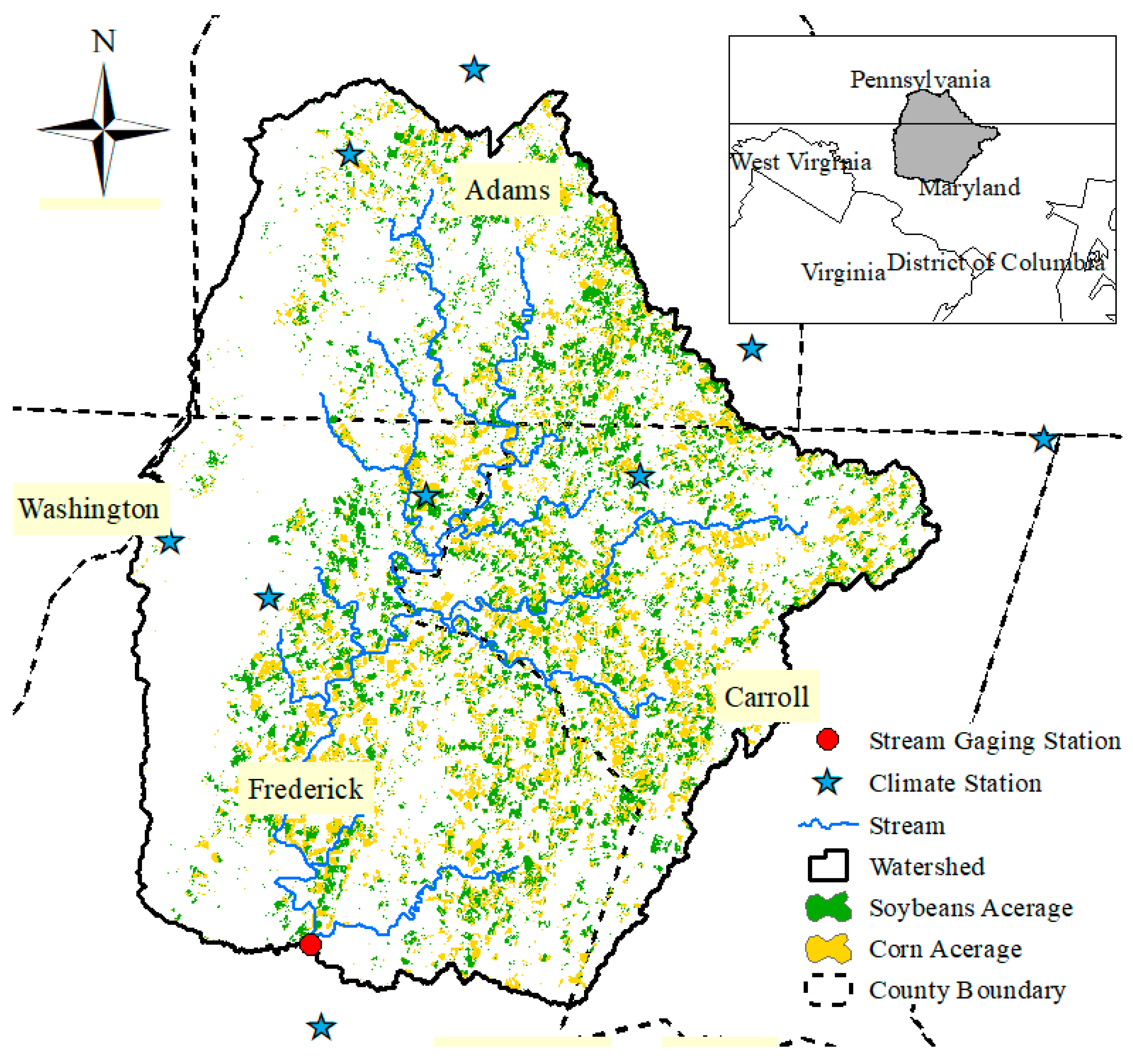
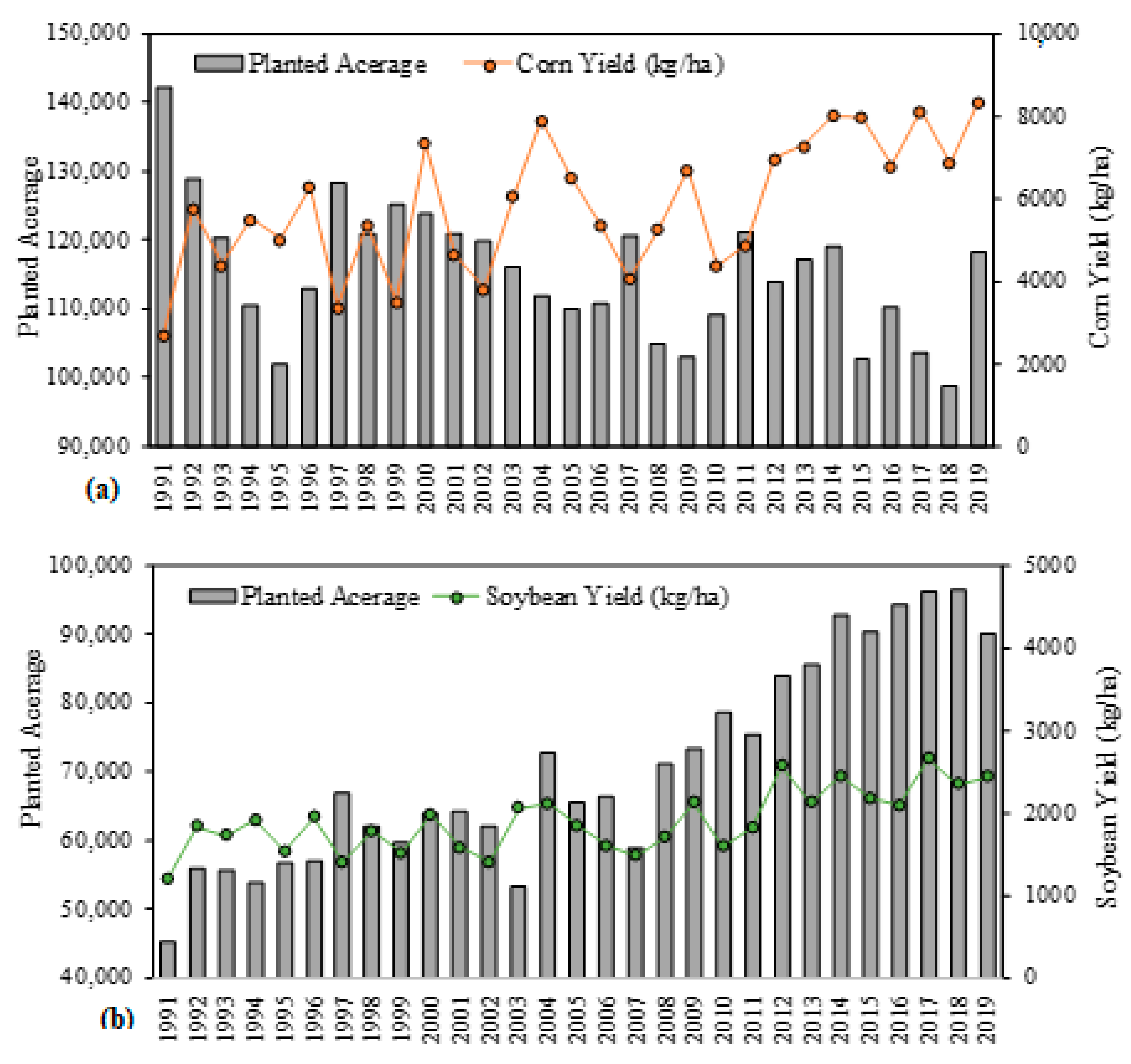

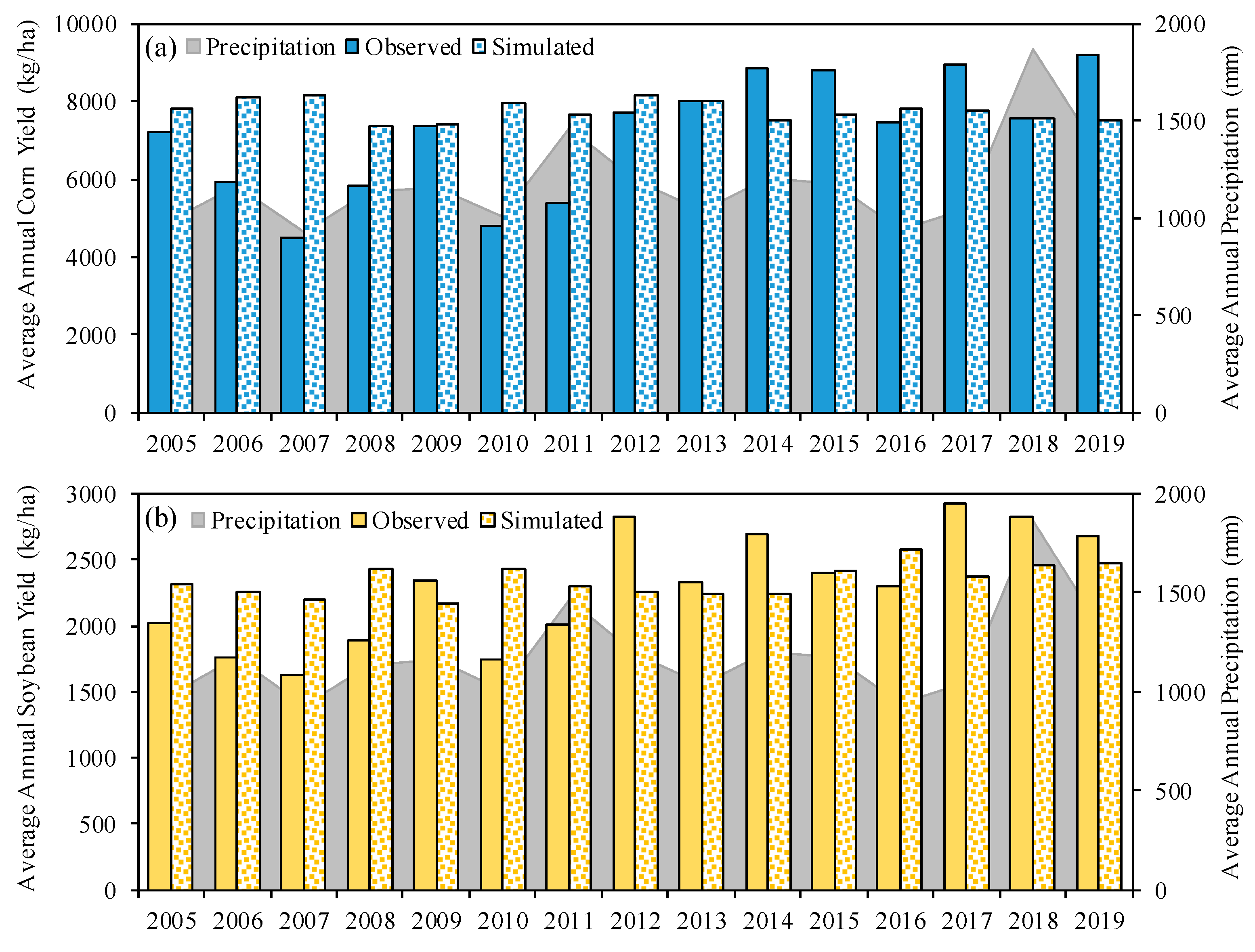
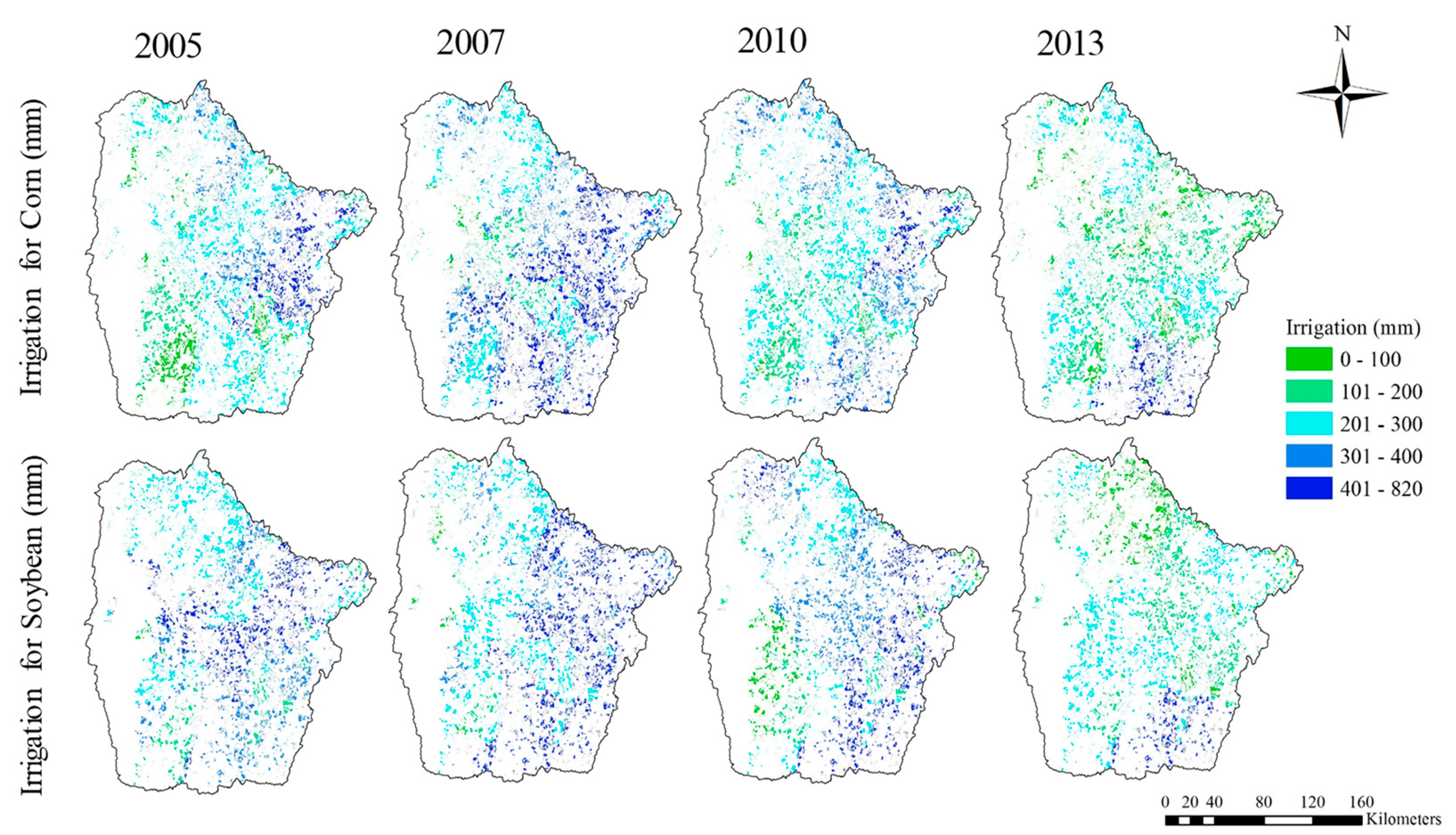

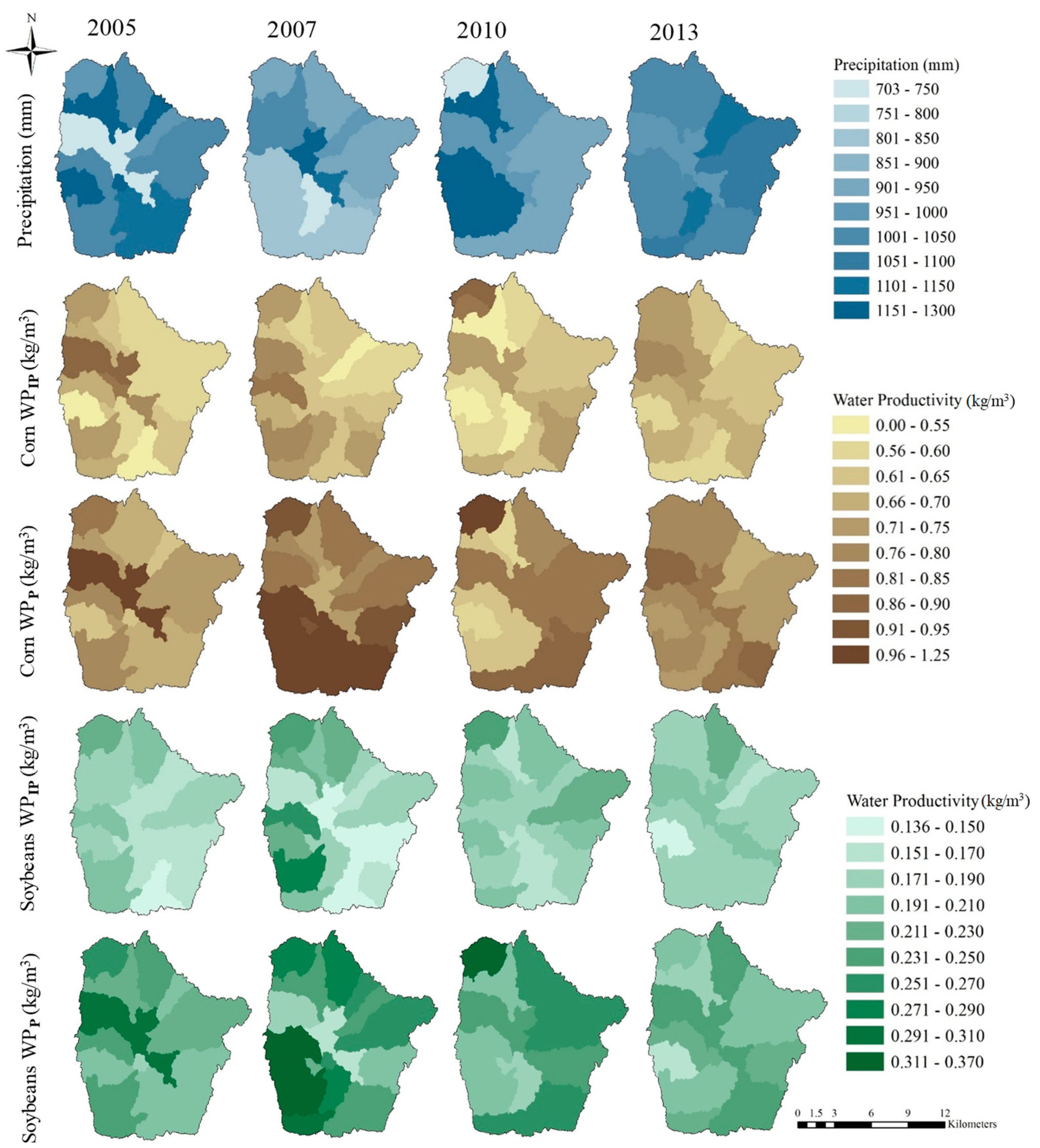
| Land Use and Land Cover | Area (acres) | Area (km2) | % of Watershed Area |
|---|---|---|---|
| Forest | 189,307.88 | 766.10 | 36.24 |
| Urban Area | 68,957.65 | 255.12 | 12.07 |
| Grassland | 1243.05 | 5.03 | 0.24 |
| Water | 662.31 | 2.68 | 0.13 |
| Agricultural Land | 76,200.67 | 1085.06 | 51.33 |
| Hay | 75,540.25 | 305.70 | 14.46 |
| Corn | 68,321.40 | 276.49 | 13.08 |
| Pasture | 58,279.52 | 235.85 | 11.16 |
| Soybean | 56,368.50 | 228.12 | 10.79 |
| Winter Wheat | 8315.58 | 33.65 | 1.59 |
| Alfalfa | 935.82 | 3.79 | 0.18 |
| Apple | 362.05 | 1.47 | 0.07 |
| Parameter | Definition | Initial Range | Calibrated Value |
|---|---|---|---|
| SOL_K | Soil saturated hydraulic conductivity (mm/h) | −25 to 25 | 10.95 |
| SOL_AWC | Available soil water capacity (mm H2O/mm soil) | −25 to 25 | 3.95 |
| ALPHA_BF | Baseflow recession constant (days) | 0.01 to 1 | 0.680 |
| GW_DELAY | Groundwater delay (days) | 1 to 500 | 113.5 |
| GW_REVAP | Groundwater “revap” coefficient | 0.01 to 0.2 | 0.011 |
| REVAPMN | Re–evaporation threshold (mm H2O) | 0.01 to 500 | 273.5 |
| GWQMN | Threshold groundwater depth for return flow (mm H2O) | 0.01 to 5000 | 115.0 |
| CN2 | Curve number for moisture condition II | −0.3 to 0.3 | 0.011 |
| EPCO | Plant uptake compensation factor | 0.01 to 1 | 0.855 |
| ESCO | Soil evaporation compensation factor | 0.01 to 1 | 0.717 |
| CH_N(2) | Main channel Manning’s n | 0.01 to 0.15 | 0.059 |
| CH_K(2) | Main channel hydraulic conductivity (mm/h) | 5 to 500 | 165.2 |
| SFTMP | Snowfall temperature (°C) | 0 to 5 | 2.1 |
| SMFMN | Melt factor for snow on 21 December (mm H2O/°C–day) | 0 to 10 | 7.1 |
| SMFMX | Melt factor for snow on 21 June (mm H2O/°C–day) | 0 to 10 | 7.3 |
| SMTMP | Snowmelt base temperature (°C) | −2 to 5 | 3.1 |
| TIMP | Snowpack temperature lag factor | 0 to 1 | 0.35 |
| Parameter | Unit | Parameter Definition | Corn | Soybean | ||
|---|---|---|---|---|---|---|
| Default | Calibrated | Default | Calibrated | |||
| BIO_E | (kg/ha)/(MJ/m2) | Radiation use efficiency or biomass energy ratio | 39 | 40 | 25 | 25 |
| HVSTI | (kg/ha)/(kg/ha) | Harvest index for optimal growing season | 0.5 | 0.5 | 0.31 | 0.3 |
| WSYF | (kg/ha)/(kg/ha) | Lower limit of harvest index | 0.3 | 0.3 | 0.01 | 0.01 |
| BLAI | (m2/m2) | Maximum potential leaf area index | 6 | 6 | 3 | 3 |
| DLAI | Fraction of growing season when leaf growth declines | 0.7 | 0.7 | 0.6 | 0.5 | |
| With Irrigation | Without Irrigation | ||||
|---|---|---|---|---|---|
| RYR (%) | RMSE (kg/ha) | RYR (%) | RMSE (kg/ha) | ||
| Corn | Calibration | −18.97 | 1596.8 | −24.08 | 1863.5 |
| Validation | 8.78 | 610.4 | −11.64 | 873 | |
| Soybean | Calibration | −7.48 | 373.2 | 23.81 | 501.8 |
| Validation | 6.23 | 191.3 | 32.74 | 512.2 | |
| Subbasin No. | Area (km2) | Wastewater Treatment Plant | ||
|---|---|---|---|---|
| Corn | Soybean | Flow (MGD) | Discharge Method | |
| 3 | 3.70 | 3.06 | 2.00 | Outfall to surface waters |
| 0.16 | ||||
| 4 | 1.22 | 0.93 | 0.31 | |
| 6 | 1.79 | 0.77 | 0.67 | |
| 7 | 0.19 | 0.17 | 0.06 | |
| 0.02 | ||||
| 8 | 0.43 | 0.62 | 0.18 | |
| 10 | 1.45 | 0.52 | 0.63 | |
| 11 | 1.65 | 1.17 | 0.56 | Spray irrigation |
| 18 | 0.66 | 0.36 | 0.11 | Outfall to surface waters |
| 20 | 1.03 | 0.83 | 0.91 | |
| 22 | 5.8 | 4.01 | 3.28 | |
| 0.09 | ||||
| 23 | 1.91 | 1.48 | 0.04 | |
| 0.56 | Spray irrigation | |||
| 24 | 0.24 | 0.17 | 0.08 | Outfall to surface waters |
| 26 | 0.85 | 0.63 | 0.63 | |
| 27, 29 | 4.52 | 4.71 | 6.50 | |
| 28 | 4.41 | 3.56 | 3.97 | |
Publisher’s Note: MDPI stays neutral with regard to jurisdictional claims in published maps and institutional affiliations. |
© 2021 by the authors. Licensee MDPI, Basel, Switzerland. This article is an open access article distributed under the terms and conditions of the Creative Commons Attribution (CC BY) license (https://creativecommons.org/licenses/by/4.0/).
Share and Cite
Paul, M.; Negahban-Azar, M.; Shirmohammadi, A. Assessing Crop Water Productivity under Different Irrigation Scenarios in the Mid–Atlantic Region. Water 2021, 13, 1826. https://doi.org/10.3390/w13131826
Paul M, Negahban-Azar M, Shirmohammadi A. Assessing Crop Water Productivity under Different Irrigation Scenarios in the Mid–Atlantic Region. Water. 2021; 13(13):1826. https://doi.org/10.3390/w13131826
Chicago/Turabian StylePaul, Manashi, Masoud Negahban-Azar, and Adel Shirmohammadi. 2021. "Assessing Crop Water Productivity under Different Irrigation Scenarios in the Mid–Atlantic Region" Water 13, no. 13: 1826. https://doi.org/10.3390/w13131826
APA StylePaul, M., Negahban-Azar, M., & Shirmohammadi, A. (2021). Assessing Crop Water Productivity under Different Irrigation Scenarios in the Mid–Atlantic Region. Water, 13(13), 1826. https://doi.org/10.3390/w13131826








